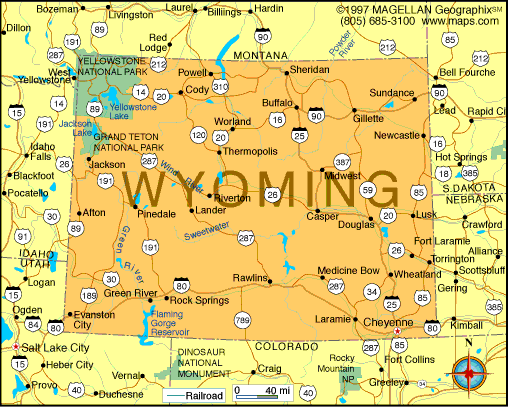Wyoming

Wyoming State Facts
Entered Union: July 10, 1890 (44th State)
Organized as territory: May 19, 1869
Present constitution adopted: 1890
Fun Facts
State abbreviation/Postal code: Wyo./WY
Nicknames: Equality State; Cowboy State
Origin of name: Named for the Wyoming Valley in Pennsylvania. Competing origins from Delaware, Munsee, or Algonquin words.
Motto: "Equal rights"
Slogan: "Like No Place on Earth"
State symbols:
Bird: Western meadowlark (1927)
Fish: Cutthroat trout (1987)
Insect: Sheridan's green hairstreak butterfly (2009)
Mammal: American bison (1985)
Reptile: Horned toad (1993)
Flower: Indian paintbrush (1917)
Grass: Western wheatgrass (2007)
Tree: Plains cottonwood (1947)
Dinosaur: Triceratops (1994)
Fossil: Knightia (1987)
Gemstone: Jade (1967)
Sport: Rodeo (2003)
Song: "Wyoming" (1955)
Government
Capital: Cheyenne
State Website: www.wyo.gov
Governor: Matt Mead, R (to Jan. 2019)
Secy. of State: Ed Murray, R (to Jan. 2019)
Treasurer: Mark Gordon, R (to Jan. 2019)
Atty. General: Peter K. Michael, R (appt'd. by gov.)
U.S. Representatives: 1
Senators: Michael B. Enzi, R (to Jan. 2021); John Barrasso, R (to Jan. 2019)
See Also: Historical biographies of Wyoming Congress members
Population
Residents: Wyomingite
Resident population: 585,501 (50th Largest State, 2016)
10 largest cities (2010): Cheyenne, 59,011; Casper, 55,316; Laramie, 30,816; Gillette, 29,087; Rock Springs, 23,036; Sheridan, 17,444; Green River, 12,515; Evanston, 12,359; Riverton, 10,615; Cody, 9,520
Race/Ethnicity: White (90.7%); Black (0.8%); American Indian (2.4%); Asian (0.8%); Other race (3%); Two or more races (2.2%); Hispanic/Latino (8.9%).
Religion: Protestant (43%); No religion/Unaffiliated (26%); Catholic (14%); Mormon (9%); Jehovah's Witness (3%); Other Christian (1%); Buddhist (1%); Other (3%).
Sex: Male (51%); Female (49%).
Age: Under 18 (24%); 18-64 (63.6%); 65 and over (12.4%). Median Age: 36.8
See Also: Additional Wyoming Census Data
Economy
GDP: 40 billion dollars (49th in U.S., 2017)
Unemployment: 4.0% (2015)
Overview: The state of Wyoming is over 90% rural, with an economy suited for its sparse population. An overwhelming majority of the state economy is concentrated in three sectors: agriculture, energy, and nature tourism. Over 6 million visitors travel to Wyoming's parks each year, and the areas around these see the most growth. The state is also a major producer of beef, wool, wind power, coal, and uranium.
Geography
Land area: 97,914 sq mi (253,600 km2)
Geographic center: In Fremont Co., 58 mi. ENE of Lander
Number of counties: 23, plus Yellowstone National Park
Largest county by population and area: Laramie, 91,738 (2010); Sweetwater, 10,426 sq mi.
State parks/historic sites: 24
Area codes
Tourism office
See more on Wyoming:
Encyclopedia: Wyoming
Encyclopedia: Geography
Encyclopedia: Economy
Encyclopedia: Government
Encyclopedia: History
Monthly Temperature Extremes
Wyoming State History
The U.S. acquired the land comprising Wyoming from France as part of the Louisiana Purchase in 1803. John Colter, a fur-trapper, is the first white man known to have entered the region. In 1807 he explored the Yellowstone area and brought back news of its geysers and hot springs.
Robert Stuart pioneered the Oregon Trail across Wyoming in 1812–1813 and, in 1834, Fort Laramie, the first permanent trading post in Wyoming, was built. Western Wyoming was obtained by the U.S. in the 1846 Oregon Treaty with Great Britain and as a result of the treaty ending the Mexican War in 1848.
When the Wyoming Territory was organized in 1869, Wyoming women became the first in the nation to obtain the right to vote. In 1925 Mrs. Nellie Tayloe Ross became the first woman governor in the United States.
Wyoming's towering mountains and vast plains provide spectacular scenery, grazing lands for sheep and cattle, and rich mineral deposits.
Wyoming is the leading coal-producing state and a leader in the production of petroleum and natural gas. Wyoming has the world's largest sodium carbonate (natrona) deposits and has the nation's second largest uranium deposits.
A leading producer of sheep and wool, Wyoming is also a major producer of beef cattle and hogs. Principal crops include wheat, oats, sugar beets, corn, barley, and alfalfa.
Second in mean elevation to Colorado, Wyoming has many attractions for the tourist trade, notably Yellowstone National Park . Hikers, campers and skiers are attracted to Grand Teton National Park and Jackson Hole National Monument in the Teton Range of the Rockies. Cheyenne is famous for its annual “Frontier Days†celebration. Flaming Gorge, the Fort Laramie National Historic Site, and Devils Tower and Fossil Butte National Monuments are other points of interest.
Wyoming was selected as an official state of the Free State Project, a political migration. The plan was to have all Libertarians relocate to one state so they could live free. The project was started in 2001. Members voted on select states for the migration. Wyoming received 498 votes, coming in second behind New Hampshire.
Famous Wyoming Natives and Residents
James Bridger trapper, guide, and storyteller;
Dick Cheney vice president;
Buffalo Bill Cody scout;
John Colter trader and first white man to enter Wyoming;
Thomas Fitzpatrick mountain man and guide;
Harrison Ford actor;
Matthew Fox actor;
Curt Gowdy sportscaster;
Jackson Pollock painter;
Matthew Shepard murdered student;
Jedediah S. Smith mountain man
Willis Van Devanter jurist;
U.S. State Comparisons
Population & Economy
Historical Population Statistics, 1790–Present
Per Capita Personal Income
Minimum Wage Rates
State Taxes
Federal Government Expenditure
Percent of People in Poverty
Births and Birth Rates
Homeownership
Percentage of Uninsured by State
Society & Culture:
Most Livable States
Healthiest States
Most Dangerous States
Smartest States
Crime Index
Residency Requirements for Voting
Compulsory School Attendance Laws
Driving Laws
Geography & Climate
Record Highest Temperatures
Record Lowest Temperatures
Highest, Lowest, and Mean Elevations
Land and Water Area

